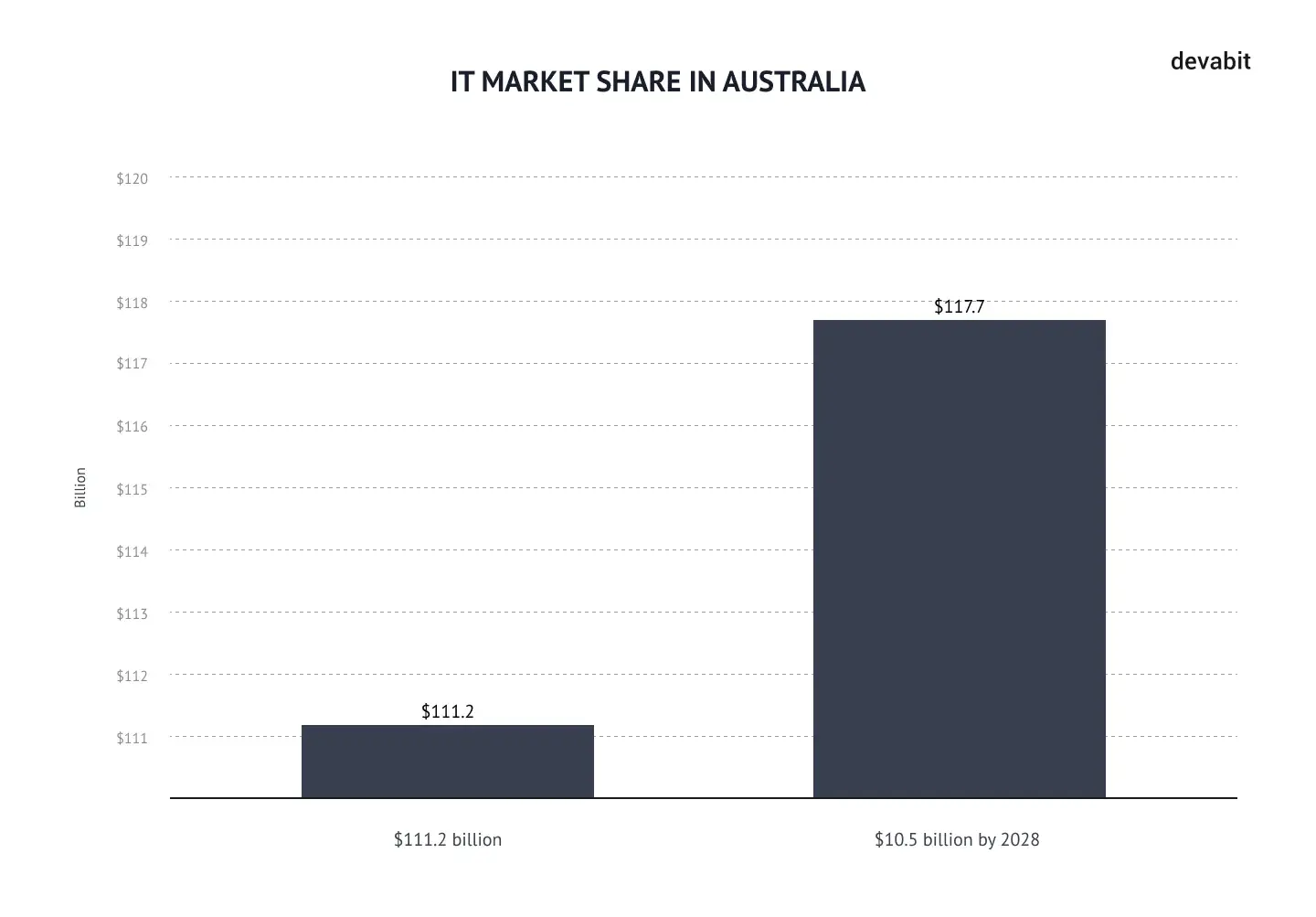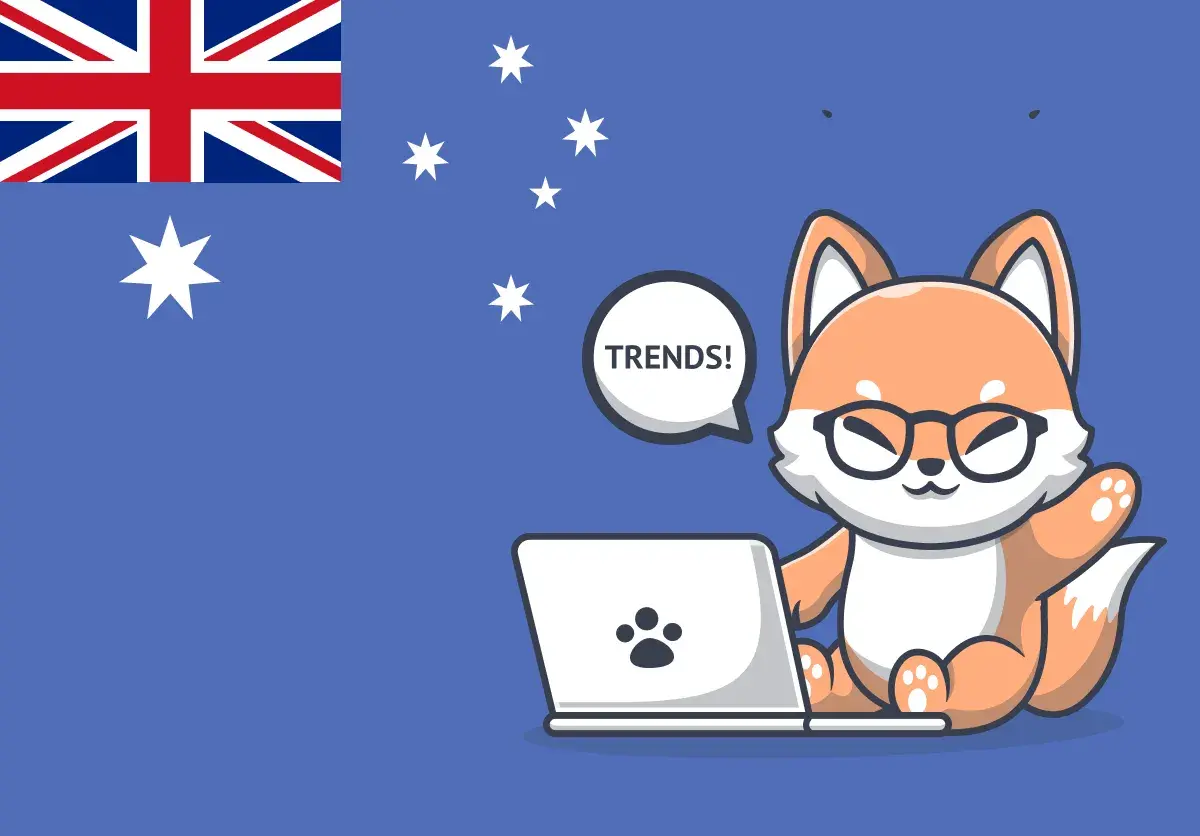10 Insights into the IT Industry in Australia
Nowadays, the IT industry in Australia is one of the most dynamic and rapidly evolving sectors. As one of the most highly urbanized countries, Australia is also the offspring of multiple technological innovations like wi-fi technology and Google maps. With new technologies emerging constantly, the IT industry in Australia is a hotbed of innovation, research, and development. Owing to a highly developed market economy, the government empowers local businesses, including software development providers, to improve technologically, build innovative products and discover new markets. Yet, where is the IT industry in Australia headed now? This and many more questions we are going to answer today. In this article, we have gathered all tech insights to uncover the future of the IT industry in Australia. Ready, set... Let us crush the 10 insights into the IT industry in Australia together!
In short, today we will take a look at the following topics:
- The IT market in Australia is expected to reach $117.7 billion by 2028.
- In recent years, nearly half of the IT industry in Australia has reached a digital maturity point (either 20% in terms of scale or full profit), which has positively impacted the growth of the Australian IT sector.
- The IT industry in Australia focuses mainly on customer experience instead of diversifying revenue sources.
- The IT industry in Australia prioritizes a combination of transferable digital knowledge and creative, problem-solving, and communication skills.
- As digital systems and automation get embraced across all industries, companies meet shortages in key digital skills, such as data management and analysis, cybersecurity, cloud computing, AI, etc.
- The Australian government has launched the Small Business Digital Champions initiative to support small businesses in their digital engagement.
- Artificial Intelligence is forecasted to add trillions of dollars to the global economy in the upcoming decades, so the IT industry in Australia will definitely benefit from the adoption of AI.
- Speaking of the IT industry in Australia, blockchain technology is adopted primarily in the financial, banking, and governmental areas.
- In Australia, we are seeing many examples of IoT use across various business domains.
- The IT industry in Australia is recognized as a world leader in silicon-based quantum computing research.
1. IT Industry in Australia: Relevant Statistics You Should Know
According to the latest report on technology spending released by Gartner, it is expected that the IT sector in Australia will witness a significant growth of 5.8% in 2023. The technology analyst firm also has predicted that IT spending in Australia will reach almost $117.7 billion in 2023, which is a substantial increase from $111.2 billion in 2022. Such intensive growth indicates the robust nature of the IT industry in Australia and its ability to adapt to the constantly evolving technology landscape. Moreover, with increased investment in research and development, a thriving startup ecosystem, and growing demand for skilled IT professionals, the industry is destined for continued growth and success. In fact, this year is an exciting time for the IT sector in Australia, and the projected increase in spending is a testament to its significant contribution to the country's economy.

2. How the Maturation of Digital Business Influences the IT Industry in Australia
The maturation of digital businesses in Australia can be caused by several factors:
- The widespread adoption of digital technologies has made it easier for companies to reach customers and operate online. This has created new business models, such as e-commerce and online marketplaces, which are now driving the growth of the digital economy.
- The rise of digital natives, who are more comfortable with technology, has resulted in increased demand for digital services. This, in turn, has led to the emergence of new business opportunities, especially in FinTech and HealthTech.
- The global COVID-19 pandemic has accelerated the adoption of digital technologies, as businesses have had to adapt to remote work and digital communication.
Speaking of statistical data, nearly half of the IT industry in Australia submitted reaching a digital maturity point in Gartner's survey. It means they either have hit over 20% in terms of scale or are already running it for profit. There are two primary ways of routing for digital: robotic process automation (RPA) and digital transformation headed by chief digital officers.

3. IT Industry in Australia & Conservative risk appetites for business innovations
Australia is taken as a much less dynamic economy compared to Southeast Asia and China. While the latter strive to diversify revenue sources and re-invent businesses, the IT industry in Australia appears more mature and focuses mainly on customer experience. Besides, they illustrate a rather careful attitude to technological risks and innovations compared to the rest of the world.
By adopting a collaborative approach to innovation and focusing on niche markets, the Australian business ecosystem finds efficient ways to overcome emerging challenges and achieve success in the industry. Additionally, as the IT industry in Australia continues to grow and evolve, we will likely see more innovative companies emerge, pushing the existing boundaries and driving growth and prosperity in the Australian economy.
4. Business success relies on a highly-skilled workforce in the future-focused IT industry in Australia
Future workforce demand is still hard to forecast. However, one thing is for sure: technologies impact the way the IT industry in Australia operates as well as the demand for skilled employees. So far, the priority is given to the combination of transferable digital knowledge and creative, problem-solving, and communication skills.
In recent years, the Australian government announced only migrants working in seven future-focused fields to be eligible for permanent residency under Global Talent Independent Program (GTIP). These fields include:
- agriculture technology (AgTech);
- FinTech;
- MedTech;
- space and advanced manufacturing;
- energy and mining technology;
- cybersecurity;
- information and communication technology (ICT: data science, advanced digital and quantum information).

5. Shortage of qualified employees due to rapid tech changes and automation in the IT Industry in Australia
Technological influence is likely to be uneven in the job market. Various industries and regions are automating low-qualified work leaving many Australians unemployed or underemployed. Soon the country will face a sharp lack of skills for securing well-paid job offers. Thus, government and businesses should unite efforts and promote opportunities for upskilling, reskilling, and transiting skills into new industries. Soon we will see a massive shift from a career-for-life concept to a culture of lifelong learning.
On the contrary, as digital systems and automation get embraced across all industries, companies meet shortages in key digital skills, including:
- data management and analysis;
- cybersecurity;
- cloud computing;
- artificial intelligence and machine learning;
- robotics;
- digital and software design;
- advanced mathematics and statistics.

6. SMEs are yet to embrace and adopt digital technologies in the IT industry in Australia
Undoubtedly, business capability of digitalization enforces competitiveness, raises revenue, embraces product innovations and creates new job opportunities. However, the adoption level of digital technologies by small and medium enterprises (SMEs) remains low due to a number of barriers, including:
- lack of awareness regarding the benefits;
- lack of resources and time to research and try new technologies;
- low digital skills;
- concerns about costs.
The Australian government has launched the Small Business Digital Champions initiative to assist small companies in digital engagement. Generally speaking, the main steps to better adopting digital technologies are:
- upgrade to modern cloud-based solutions;
- use web channels to extend business opportunities;
- adopt emerging technologies as they evolve;
- develop in-house digital expertise.

7. Artificial Intelligence (AI)
AI describes various technologies meant to perform without explicit human guidance. It includes automation, machine learning, NLP, computer vision, optimization, and decision support, to name a few. Adoption of AI technologies is at the 40% level compared to 41% worldwide. Artificial Intelligence is forecasted to add trillions of dollars to the global economy in upcoming decades, so the IT industry in Australia will definitely benefit from the adoption of AI in 2023 and beyond.
8. Blockchain
Still an emerging technology, blockchain is applied across many industries and to almost any value transaction. A digital platform of blockchain allows the recording, verifying, and storing of transactions shared across a computer network based on pre-agreed rules. While this excludes the need for authority verification, cryptography keeps transactions secure. When it comes to the IT industry in Australia, blockchain technology is used primarily in the financial, bank, and governmental sectors.

9. Internet of Things (IoT)
The spread of IoT technology became possible thanks to cheaper and better sensors and increased computing power. Next-generation IoT platforms will integrate innovative and traditional data sources, correlate multiple data inputs and provide real-time analysis. Speaking of the IT industry in Australia, we are seeing many examples of IoT uses across various business domains:
- Universities are implementing smart campuses to collect data on how spaces are used, monitor study patterns, course attendance and student interactions. Then the data is leveraged to optimise resources, improve student experience, etc.
- Smart healthcare devices are used by Australian medical authorities to monitor patients and alert about issues.
- Energy and water infrastructure sector are using sensors to better track and handle the maintenance.
- Soil sensors help farmers to measure moisture levels and manage water use to improve harvest.

10. Quantum Computing
IT industry in Australia is recognized as a world leader in silicon-based quantum computing research. This is one of the most promising technologies to build a commercially viable quantum computer. As part of the National Innovation and Science Agenda, Australian government invested $25 million in the Silicon Quantum Computing Pty Ltd venture, in partnership with business.

Looking for the right software development partner in the IT industry in Australia?
Even though devabit is a strategic technology and business partner located in Ukraine, we possess a deep knowledge of the IT industry in Australia and can provide you with a cutting-edge software solution of any type and complexity. For many years, we have delivered high-quality end-to-end solutions for industry leaders within our core competencies. We own a proven record of expertise in software and mobile development, UI/UX, 3D product visualization, and BPO.
Thanks to the agile approach, we deliver every stage of development, from investigation to post-delivery support, quickly and effectively. If you are searching for the right outsourcing vendor, contact us, and we will immediately provide you with a tailored business consultancy.

Recent Publications
Don't miss out! Click here to stay in touch.
Discover More

Relevant Articles View all categories
View all categories CONNECT WITH US WE’RE READY
TO TALK OPPORTUNITIES
THANK YOU! WE RECEIVED YOUR MESSAGE.
Sorry
something went wrong



